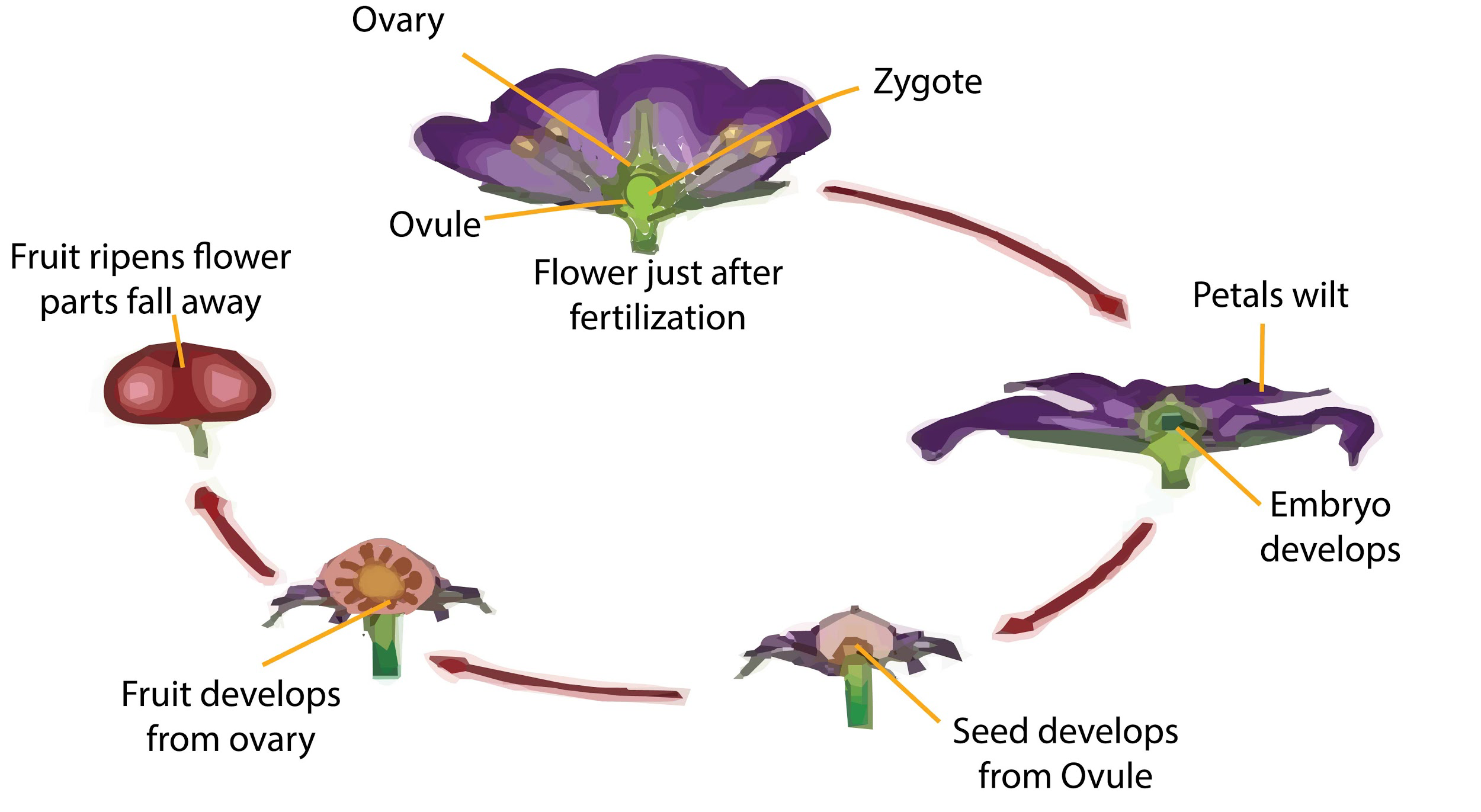Answer
395.4k+ views
Hint: Fertilization is the process of fusion of the male and female gametes to form a zygote that results in the process of fertilization and leads to the formation of the seeds from which a new plant is developed.
Complete answer:
The flowering plants (angiosperms) consist of a 7-celled gametophyte which has two polar nuclei, one egg cell, two synergids, and three antipodal cells. The two male gametes are produced, one of the male gametes fuses with an egg cell and forms a zygote while the other one gamete fuses with the polar nuclei which result in the formation of the endosperm.
After this process of double fertilization, several changes may occur which includes:
-The development of the embryo and the endosperm.
-The development of the ovules into the seeds.
-The ovary will develop and mature to form a fruit.
-The zygote will undergo certain division and give rise to two cells, one is the basal cell and the other is the terminal cell.
-The basal cell will undergo divisions to form a suspensor, which helps in providing nutrition and attachments to the plants.
-The terminal cell will undergo various divisions to form an embryo which will again divide to form a different embryonal stage and further divides and mature to form a seed.
-The outer sepals and petals along with the stamens of the flowers will fall off while the pistil remains attached to the flower.
-The wall of the ovary will form a protective covering outside the fruit which is known as the pericarp.

Note: In 1884, Strasburger showed that the pollen tube releases two male nuclei along with the vegetative nucleus inside the embryo sac. Later Nawaschin discovered that the event of fertilization involved two events in the case of the flowering plants. In animals, the process of fertilization first showed by Wilhelm August Oscar Hertwig.
Complete answer:
The flowering plants (angiosperms) consist of a 7-celled gametophyte which has two polar nuclei, one egg cell, two synergids, and three antipodal cells. The two male gametes are produced, one of the male gametes fuses with an egg cell and forms a zygote while the other one gamete fuses with the polar nuclei which result in the formation of the endosperm.
After this process of double fertilization, several changes may occur which includes:
-The development of the embryo and the endosperm.
-The development of the ovules into the seeds.
-The ovary will develop and mature to form a fruit.
-The zygote will undergo certain division and give rise to two cells, one is the basal cell and the other is the terminal cell.
-The basal cell will undergo divisions to form a suspensor, which helps in providing nutrition and attachments to the plants.
-The terminal cell will undergo various divisions to form an embryo which will again divide to form a different embryonal stage and further divides and mature to form a seed.
-The outer sepals and petals along with the stamens of the flowers will fall off while the pistil remains attached to the flower.
-The wall of the ovary will form a protective covering outside the fruit which is known as the pericarp.

Note: In 1884, Strasburger showed that the pollen tube releases two male nuclei along with the vegetative nucleus inside the embryo sac. Later Nawaschin discovered that the event of fertilization involved two events in the case of the flowering plants. In animals, the process of fertilization first showed by Wilhelm August Oscar Hertwig.
Recently Updated Pages
How do you arrange NH4 + BF3 H2O C2H2 in increasing class 11 chemistry CBSE

Is H mCT and q mCT the same thing If so which is more class 11 chemistry CBSE

What are the possible quantum number for the last outermost class 11 chemistry CBSE

Is C2 paramagnetic or diamagnetic class 11 chemistry CBSE

What happens when entropy reaches maximum class 11 chemistry JEE_Main

Calculate the volume occupied by 88 gram of CO2 at class 11 chemistry CBSE

Trending doubts
Difference Between Plant Cell and Animal Cell

Difference between Prokaryotic cell and Eukaryotic class 11 biology CBSE

What is BLO What is the full form of BLO class 8 social science CBSE

Change the following sentences into negative and interrogative class 10 english CBSE

Fill the blanks with the suitable prepositions 1 The class 9 english CBSE

The cell wall of prokaryotes are made up of a Cellulose class 9 biology CBSE

What organs are located on the left side of your body class 11 biology CBSE

Select the word that is correctly spelled a Twelveth class 10 english CBSE

a Tabulate the differences in the characteristics of class 12 chemistry CBSE



